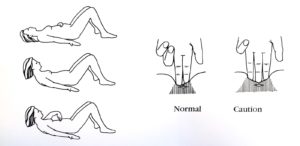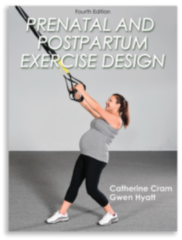During pregnancy one of the changes that occur to allow room for the baby to grow is hormonally induced thinning and widening of the linea alba (the fibrous tissue that connects the recti muscles). This widening of the interrecti distance is termed a diastasis recti abdominus (DRA). A DRA occurs in nearly all pregnant women by the third trimester and remains during the postpartum recovery as well. Although a DRA is a normal adaptation of pregnancy, there is some concern that the increase in intersection distance may affect the contractile strength of the abdominal muscles and pelvic muscle function.
The development of DRA can be determined and monitored using a simple test during pregnancy.
Have the pregnant client lie on her back with knees bent and feet resting on the floor. Place three fingers horizontally at the umbilicus and have the client raise her head and shoulders upward until you feel the recti muscles contract. Determine the number of fingers fit within the soft area between the two sides of the recti muscles.

A distance of two fingers or more is considered a DRA, and it’s suggested that women with this condition avoid curl up type abdominal exercises that put stress on the midline. Traditional curl up type exercises focus on the recti muscles, but when a DRA is present the intraabdominal pressure that occurs when lifting the upper body upward puts tension on the linea alba. In addition, the increased interrecti distances affect the function of the recti muscles, causing recruitment of other muscle groups to rise up.
It’s important for pregnant women to maintain abdominal muscle strength throughout pregnancy by including exercises that target the transverse abdominus, a key support for the lower abdomen and pelvic floor. One of my favorite group of transverse muscle exercises are the Sahrmann series. I’ve modified these supine exercises for pregnancy, and you can see examples of the exercises at: https://www.youtube.com/watch?v=tdMjeeqUWLo



